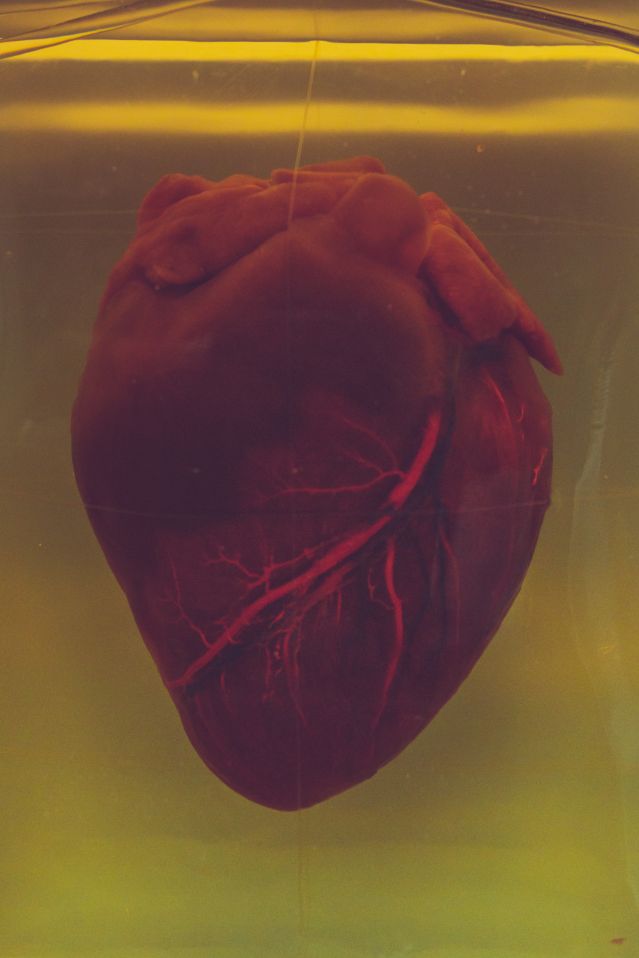Bulimia Nervosa
How Bulimia Nervosa Impacts the Heart
Bulimia nervosa can have a substantial impact on heart health.
Posted November 21, 2023 Reviewed by Abigail Fagan
Key points
- Bulimia nervosa is an eating disorder involving binge eating and purging behaviors.
- Routine purging behaviors can contribute to irregular heartbeats.
- It is vital for individuals with a history of bulimia nervosa to disclose this information to their doctors.

Bulimia nervosa (BN) is an eating disorder where individuals engage in two distinct behaviors, binge eating and purging, at least once a week for several months.
Binge eating is defined as eating an atypically large amount of food during a distinct period of time (e.g., two hours). During a food binge, people with BN feel as though they have no control over how much they are eating, which results in eating past satiation.
Purging behaviors, in contrast, are routine behaviors (e.g., overexercising, vomiting, fasting, and/or medication use) done over extended periods of time (e.g., three months) to prevent weight gain. Purging behaviors separate BN from a similar eating disorder: binge eating disorder (BED). While people with BED and BN both binge eat, only people with BN purge to prevent weight gain.
Individuals with BN also experience body size and shape dissatisfaction, as well as a fear of weight gain. Despite this fear of weight gain, people with BN are not always underweight. Rather, it might be difficult to tell if someone has BN based on their visual appearance alone.
An estimated 3% of women report having BN at some point during their lifetime, though this estimate could be low — many individuals who engage in BN behaviors (e.g., frequent purging) are never officially diagnosed with BN.1
How Bulimia Nervosa Impacts Heart Health
Eating disorders impact every organ of the body, but the heart is especially affected by these illnesses. Different eating disorders affect the heart (and more broadly the cardiovascular system) in different ways.
In BN, purging behaviors have a substantial impact on heart health.2 Specifically, vomiting can cause dehydration and electrolyte imbalances, while diuretics and laxative use contribute to low potassium (hypokalemia) and low sodium levels.
Dehydration and electrolyte imbalances contribute to a number of heart conditions, including arrhythmias (irregular heartbeats), atypically low blood pressure at rest (hypotension) or when standing up (orthostasis), and prolonged QT intervals during the heart's electrical cycle (delays in the heart recharging).2
Arrhythmia in Bulimia Nervosa: Bradycardia
One type of irregular heartbeat, or arrhythmia, observed in people with BN is bradycardia, or a heartbeat that is atypically slow (e.g., fewer than 60 beats per minute at rest).3
There hasn't been substantial research on bradycardia in BN, but case studies show a relationship between the two conditions. In one case study, doctors found low potassium levels and bradycardia in a 25-year-old woman prior to wrist ganglion surgery.3 When determining possible causes for her irregular heartbeat the patient disclosed a history of BN to her doctor.
In a separate case study, a 39-year-old woman reported lightheadedness prior to breast augmentation surgery.3 Because lightheadedness is often associated with an arrhythmia, her doctors performed an electrocardiogram (ECG) test to observe her heart rhythm. The ECG revealed that she had bradycardia. Like the patient in the first case study, this patient disclosed a history of BN to her doctor.

Heart rhythm irregularities in BN were further explored in a study comparing R wave amplitudes in three groups of women: women diagnosed with BN, women undiagnosed with BN but with BN signs/symptoms (e.g., purging), and women without BN.4 An R wave amplitude is an ECG measure healthcare professionals (HCPs) use to assess blood flow in the heart. Results from this study revealed that women who engage in routine purging behaviors, particularly laxatives, have a decreased R wave amplitude compared to women who don't engage in routine purging behaviors. Decreased R wave amplitudes often indicate reduced blood flow to the heart's anterior, which can contribute to bradycardia.
Why individuals with BN develop bradycardia is unclear, but one explanation could be hypokalemia, or low potassium levels. Potassium maintains optimal heart function and, when potassium levels drop too low (as they do in BN), the heart's electrical signals are altered, resulting in arrhythmias.5
Another explanation for bradycardia in BN is increased vagal activity in the vagus nerves of women with BN compared to women without BN.6 Vagus nerves are long nerves in the body that connect the brain to the gastrointestinal tract to regulate different bodily processes, including cardiac function. Research shows that increased vagal activity can reduce the heart's ability to pump blood, resulting in a slow heart rate.7 Why people with BN have increased vagal activity, however, is unclear.
Arrhythmia in Bulimia Nervosa: Tachycardia
Tachycardia is another arrhythmia that has been observed in people with BN.2,6 In contrast to bradycardia, tachycardia occurs when the heart beats atypically fast (e.g., over 100 beats per minute at rest). Possible causes for tachycardia in BN include dehydration from vomiting, as well as low potassium levels from diuretics and laxative use.
Potassium irregularities contribute to tachycardia by prolonging the heart's QT interval.8,9 The QT interval is a period during the heart's electrical cycle when its ventricles contract and relax to push blood out of the heart and into the body's tissues. These actions rely on potassium to function efficiently and, when potassium levels are too low, the QT interval is prolonged. A prolonged QT interval means that the heart can't recharge fast enough, resulting in a fast heartbeat.
Two Hearts Don't Beat as One
It is unclear why some individuals with BN develop bradycardia and others develop tachycardia.

A possible explanation for why individuals with BN develop different arrhythmias could be that no two cases of BN are the same. Individuals with BN eat different diets and engage in different purging behaviors. For example, intense exercise has been shown to increase the risk of bradycardia in people with BN.10 Likewise, some individuals with BN might eat diets that result in more nutritional deficits than other diets, resulting in different electrolyte imbalances. The type, duration, and frequency of purging behaviors might also vary across individuals with BN and impact the heart's electrical signaling in different ways.
Another explanation for variations in heartbeat irregularities in BN is individual health differences. No two individuals have identical lifestyles or medical histories. For example, certain lifestyle choices (e.g., smoking, heavy alcohol use, or illicit drug use) can increase an individual's chances of developing arrhythmias.11,12 Likewise, certain medications, viral infections, or high blood pressure can put people at increased risk for developing arrhythmias.13,14,15 Individuals with BN who have lifestyles that put them at risk for developing arrhythmias might experience more heart complications than individuals with BN who don't engage in these lifestyles.
Final Thoughts
Heartbeat irregularities in relation to BN aren't discussed frequently enough, which needs to change.
Given the impact of BN on the heart, it is important for individuals to disclose their history with BN to their HCPs. It is also imperative that HCPs check patients with a history of BN for irregular heartbeats prior to preforming procedures, prescribing medications, or suggesting lifestyle changes (e.g., physical activity).
People with or recovered from BN also need to understand how their heart might be impacted by their illness. Certain lifestyle activities (e.g., smoking) could further complicate any heartbeat irregularities they might unknowingly have.
References
1.) Van Eeden AE, van Hoeken D, Hoek HW. Incidence, prevalence and mortality of anorexia nervosa and bulimia nervosa. Curr Opin Psychiatry. 2021;34:515-524.
2.) Mehler PS, Rylander, M. (2015). Bulimia nervosa - medical complications. J Eat Disord. 2015;3(12).
3.) Suri R, Poise ES, Hager WD, et al. unrecognized bulimia nervosa: a potential cause of perioperative cardiac dysrhythmias. Can J Anaesth. 1999;46:1048-1052.
4.) Green M, Rogers J, Nguyen C, et al. Cardiac risk and disordered eating: decreased R wave amplitude in women with bulimia nervosa and women with subclinical binge/purge symptoms. Eur Eat Disord Rev. 2016;24(6):455-459. doi: 10.1002/erv.2463.
5.) Ravens U, Cerbai E. Role of potassium currents in cardiac arrhythmias. EP Europace. 2008;10(10):1133-1137. https://doi.org/10.1093/europace/eun193.
6.) Peschel S, Feeling NR, Vögele C, et al. A systematic review on heart rate variability in bulimia nervosa. Neurosci Beiobehav Rev. 2016;63:78-97. https://doi.org/10.1016/j.neubiorev.2016.01.012.
7.) Capilupi MJ, Kerath SM, Becker LB. Vagus nerve stimulation and the cardiovascular system. Cold Spring Harb Perspect Med. 2020;10(2). doi: 10.1101/cshperspect.a034173.
8.) Takimoto Y, Yoshiuchi K, Kumano H, et al. QT interval and QT dispersion in eating disorders. Psychother Psychosom. 2004;73(5):324-328. doi: 10.1159/000078850.
9.) Buchanan R, Ngwira J, Amsha K. Prolinged QT interval in bulimia nervosa. BMJ Case Rep. 2011;2011:bcr0120113780. doi: 10.1136/bcr.01.2011.3780.
10.) Nagata JM, Carlson JL, Kao JM, et al. Characterization and correlates of exercise among adolescents with anorexia nervosa and bulimia nervosa. Int J Eat Disord. 2017;50(12):1394-1403. doi: 10.1002/eat.22796.
11.) D'Alessandro A, Boeckelmann I, Hammwhöner M, et al. Nicotine, cigarette smoking and cardiac arrhythmia: an overview. EJPC. 2012;19(3):297-305. https://doi.org/10.1177/1741826711411738.
12.) Krishnamoorthy S, Lip G, Lane DA. Alcohol and illicit drug use as precipitants of atrial fibrillation in young adults: a case series and literature review. AM J Med. 2009;122(9):851-856. https://doi.org/10.1016/j.amjmed.2009.02.012.
13.) Fanoe S, Kristensen D, Fink-Jensen A, et al. Risk of arrhythmia induced by psychotropic medications: a proposal for clinical management. Eur Heart J. 2014;35(20):1306-1315. https://doi.org/10.1093/eurheartj/ehu100.
14.) Lee PY, Garan H, Wan EY, et al. Cardiac arrhythmias in viral infections. J Interv Card Electrophysiol. 2023;66:1939-1953.
15.) Yildirir A, Batur MK, Oto A. Hypertension and arrhythmia: blood pressure control and beyond. Europace. 2002;4:175-182. doi:10.1053/eupc.2002.0227.


